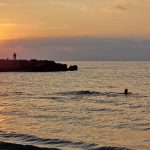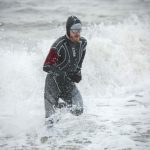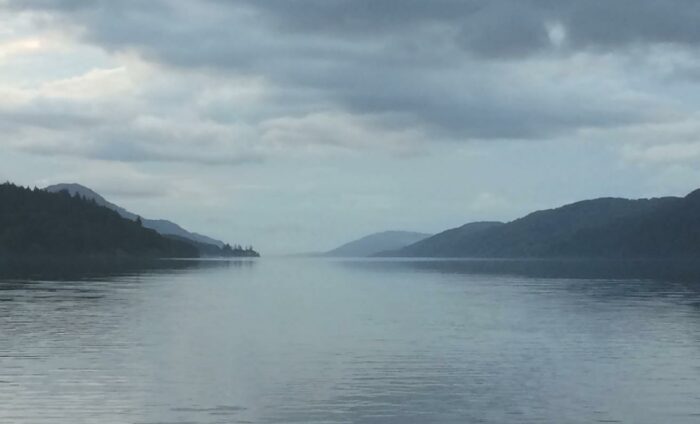
Historic swims – Loch Ness
Loch Ness has long held mystery and intrigue for those willing to stare into its depths. By Elaine K Howley
After the Roman Empire crumbled in 476 AD, western society forgot how to swim. Swimming suffered an unfortunate and unholy association with sex, the body and the Roman baths that facilitated sinful activities in the newly and starkly Christian world.
Nevertheless, a surprising reference to both the first sighting of the Loch Ness monster and perhaps the first recorded swimmer in Loch Ness occurs in the “Life of St Columba,” a work the 7th century Irish abbot and scholar Adaman wrote about his cousin St Columba’s travels across Britain to bring Christianity to the Picts a century before.
The Picts were an enigmatic, assorted collection of Celtic people who lived in eastern and northern Scotland and apparently hadn’t gotten the memo about avoiding the water. Branded as fierce “painted” people with a sophisticated culture, the Picts disappeared from historic texts around 900 AD. But it was on 22 August 565 when Columba encountered the swimmers and the lake monster as described in Book II, Chapter 28: How an Aquatic Monster was Driven Off by Virtue of the Blessed Man’s Prayer:
“On another occasion also, when the blessed man [Columba] was living for some days in the province of the Picts, he was obliged to cross the river Nesa (the Ness); and when he reached the bank of the river, he saw some of the inhabitants burying an unfortunate man, who, according to the account of those who were burying him, was a short time before seized, as he was swimming, and bitten most severely by a monster that lived in the water; his wretched body was, though too late, taken out with a hook, by those who came to his assistance in a boat. The blessed man, on hearing this, was so far from being dismayed, that he directed one of his companions to swim over and row across the coble that was moored at the farther bank. And Lugne Mocumin hearing the command of the excellent man, obeyed without the least delay, taking off all his clothes, except his tunic, and leaping into the water. But the monster, which, so far from being satiated, was only roused for more prey, was lying at the bottom of the stream, and when it felt the water disturbed above by the man swimming, suddenly rushed out, and, giving an awful roar, darted after him, with its mouth wide open, as the man swam in the middle of the stream. Then the blessed man observing this, raised his holy hand, while all the rest, brethren as well as strangers, were stupefied with terror, and, invoking the name of God, formed the saving sign of the cross in the air, and commanded the ferocious monster, saying, ‘Thou shalt go no further, nor touch the man; go back with all speed.’ Then at the voice of the saint, the monster was terrified, and fled more quickly than if it had been pulled back with ropes, though it had just got so near to Lugne, as he swam, that there was not more than the length of a spear-staff between the man and the beast. Then the brethren seeing that the monster had gone back, and that their comrade Lugne returned to them in the boat safe and sound, were struck with admiration, and gave glory to God in the blessed man. And even the barbarous heathens, who were present, were forced by the greatness of this miracle, which they themselves had seen, to magnify the God of the Christians.”
An extraordinary day on the Loch, it wouldn’t be rivalled for more than 1,400 years.
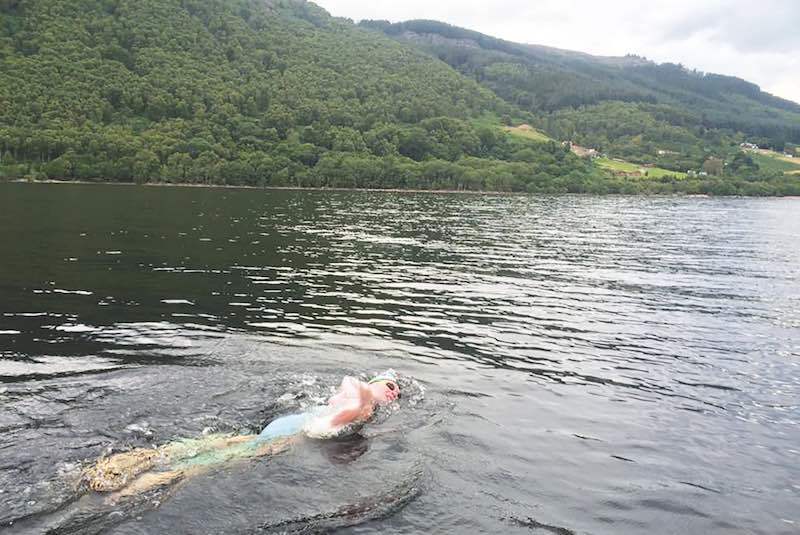
Elaine midway through her Loch Ness swim
Baiting the monster
In 1966, British teenager Brenda Sherratt became the first recorded swimmer to swim the 22.2-mile length of Loch Ness, which she did in a stunning 31 hours 27 minutes. According to the International Marathon Swimming Hall of Fame, she turned 18 during the course of the swim. Four years later, Ron Fletcher set the new standard for the crossing at 14 hours 1 minute.
On 17 August 1974, well known English Channel swimmer Michael Read, MBE, who has 33 crossings of “The Ditch” to his name and has trademarked the title “King of the Channel,” completed a solo crossing in 14 hours 24 minutes. Two years later, the other “King of the English Channel,” Kevin Murphy, who has 34 crossings under his belt, completed the swim on his second attempt in a record-setting 10 hours 30 minutes.
“My first attempt was a couple of years earlier, in 1974, when I actually went unconscious about 10 hours in. I woke up six hours later in the hospital,” Murphy says of the hypothermia he suffered in the 10 degree Celsius water. Luckily, as he fell unconscious he raised his arm just enough for a crew member to grab it. “Otherwise, I’d still be at the bottom of the Loch,” he says.
The following summer, Murphy and Australian legend Des Renford attempted a race up the Loch as part of the documentary film being shot about their rivalry, “The Great Duel: Nothing Great is Easy.” The filming schedule dictated that the swimmers have little rest between the series of three swims that began in Sydney Harbour, with a 10-mile shark-cage swim (which Murphy unexpectedly won). They then stopped for a jaunt across the English Channel (Renford was faster and both swimmers finished). And four days later, they attempted Loch Ness where Murphy led, but neither swimmer could outlast the 8 degree water. Murphy, who now runs The King’s Swimmers, a company that organises training trips in Menorca for English Channel aspirants, says the swim was “a bit of a disaster. Des lasted five hours.” He describes how Renford, who wasn’t as cold-acclimatised as Murphy, saw snow on the mountains from the train window as they travelled to Loch Ness. “From that moment on, psychologically he was beaten.” Murphy lasted “about 9 or 10 hours, but I was only three-quarters of the way down the Loch. I was suffering greatly. The film crew were taking the temperature at 8 degrees. At that stage, it was decided that I was going so slowly both because of the temperature and because it was only four days after a Channel swim, it wasn’t safe to continue.” Murphy, now 68, went on to become one of the most accomplished marathon swimmers of all time, and despite recent shoulder surgery, hints that there may still be more ahead for him.
Morgan rules the loch
On 22 August 1981, the extraordinary David Morgan of Yorkshire logged his first solo crossing of Loch Ness, finishing in 12 hours 19 minutes at age 18. His mother, Pam Morgan, recalled that not only did he swim the Loch, he did it, the English Channel and Loch Lomond all in the span of four days.
“A mate of his drove him from Loch Ness to Loch Lomond and from there to the Channel. He had crews waiting at different points. I think that was better than Loch Ness, simply because he was very lucky to be able to get in the Channel as quickly as he did. He could have been waiting weeks for the tides and weather to be right. He was fortunate that everything would fit in.”
Crossing Loch Ness is hard enough, but to do it and two other major marathon swims in the space of 96 hours is truly astounding. Morgan’s humble avoidance of the spotlight means that many people have no idea of the incredible things he did in the water as a teenager and younger man. Despite repeated attempts, I was not able to connect with Morgan. His mother says he never sought celebrity and just wanted to get on with swimming. “He could have been world famous, I think, but that’s not his way of looking at things. All he said is, ‘it’s another swim.’”
What boggles the mind even more is that he went back in 1983 and completed an astounding double crossing of Loch Ness in 23 hours 4 minutes. Zoe Sadler, recorder for the British Long Distance Swimming Association, the organisation that oversees and ratifies swims in Loch Ness, says she’s currently chasing down documentation for a rumoured fourth crossing of the Loch that Morgan may have made in the 1980s.
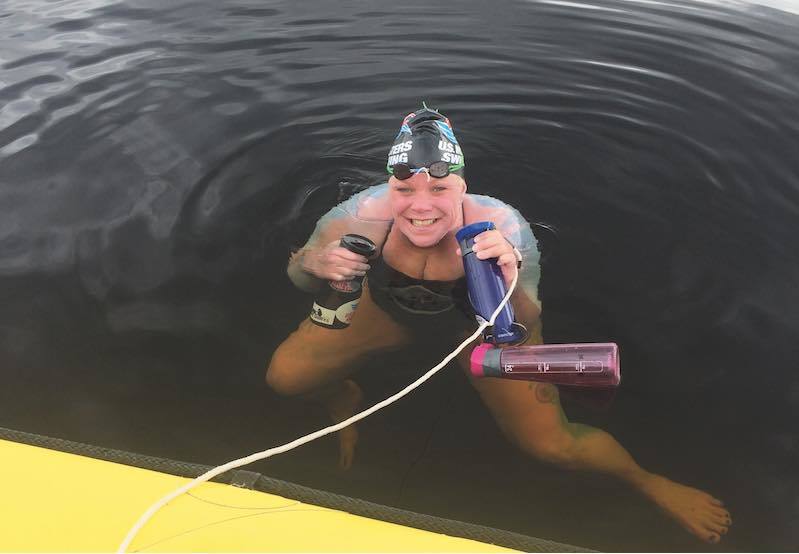
Elaine feeding on her Loch Ness swim
Interest revives
As of this writing and according to records held by the BLDSA, only 16 people have completed solo crossings of Loch Ness, half of which have occurred since 2004. There’s been a sharp increase in swims across this difficult waterway recently, likely spurred by the growth of mass events like the Monster Swim and the availability of piloting services offered by iPowerboat and Vigour Events.
On 22 August 2015, I managed (just barely) to outlast hypothermia in my bid to get from Fort Augustus to Lochend under my own power. I swam the same day as two other American marathon swimmers, Craig Lenning and Sarah Thomas, on what we didn’t know at the time was the 34th anniversary of David Morgan’s first crossing and the 1,450th anniversary of St Columba’s banishment of the monster. None of us saw a dinosaur-like creature, but that’s not because of St Columba’s intervention; rather, according to the local we met at the bar later, Nessie is shy of tourists and heads out to the Moray Firth for a quiet vacation of her own each summer.
KNOW LOCH NESS
At 23 miles (37 km) long and over 1 mile (2.7 k) wide, Loch Ness is the second largest loch in Scotland after Loch Lomond.
Dropping down to a 755ft (230 metres or 126 fathoms), Loch Ness is also the second deepest in Scotland after Loch Morar.
Yet it has the edge on water volume, holding more water that any other British loch or lake.
The very deep, very cold water in the loch is rarely above 5 degrees centigrade, although the surface temperature can rise as high as 11 C in August. Waves of between 1 and 2 metres are common after a strong wind.
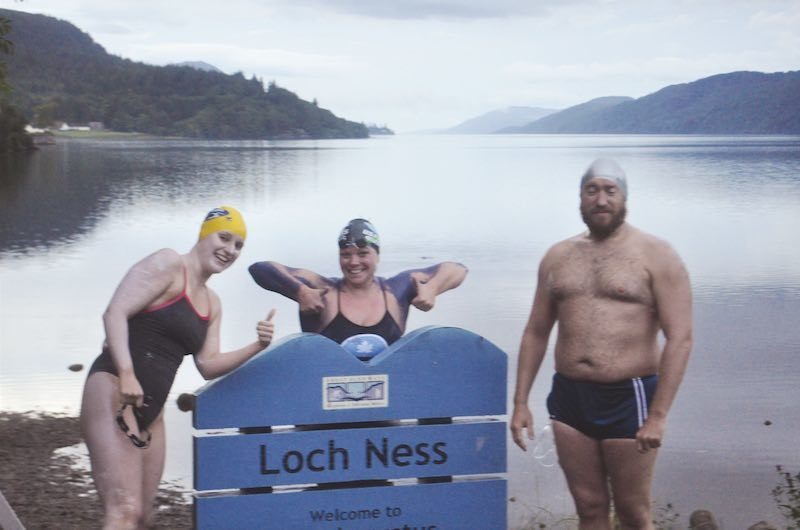
From left to right: Thomas, Howley and Lenning at the start of their swim
Current BLDSA List of Recognised Loch Ness Solo Swims
1966 – Brenda Sherratt, 31 hrs 27 mins
1970 – Ron Fletcher, 14 hrs 1 min
1974 – Michael Read, 14 hrs 24 mins 46 secs
1976 – Kevin Murphy, 10 hrs 30 mins
1981/3 – David Morgan: (1981) 12 hrs 19 mins 28 secs; (1983) 9 hrs 57 mins;
(1983) (second leg of two-way). Total time 23 hrs 4 mins (one way split 13hrs 7 mins)
1984 – Kevin McIntosh, 15 hrs 31 mins 4 secs
1995 – Rachel Godburn, 9 hrs 25 mins 37 secs
1997 – Colleen Blair, 14 hrs 32 mins 7 seconds
2004 – Liane Llewellyn, 9 hrs 49 mins 24 secs
2008 – Michael Cross, 12 hrs 9 mins 15 secs
2013 – James Leitch, 10 hrs 50 mins 9 sec
2015 – Marcella Macdonald, 11 hrs 59 mins 8 sec
2015 – Sarah Thomas, 10 hrs 52 min
2015 – Elaine Howley, 13 hrs 21 mins 41 sec
2015 – Craig Lenning, 13 hrs 47 mins 24 sec
2016 – Helen Beveridge, 18hrs 22mins 16secs





